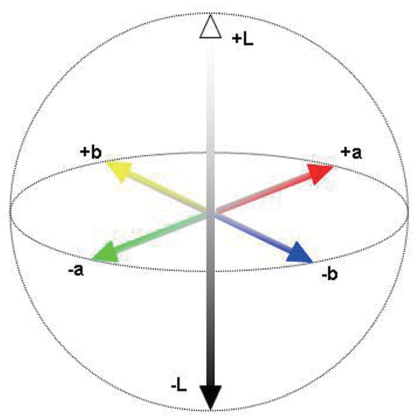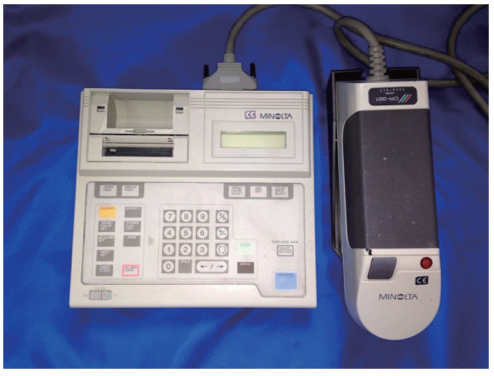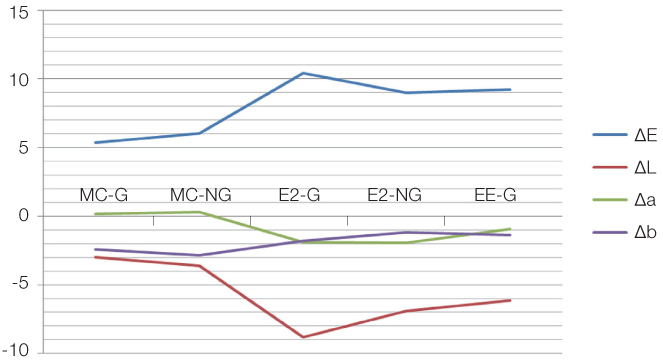J Adv Prosthodont.
2014 Dec;6(6):427-433. 10.4047/jap.2014.6.6.427.
The effect of repeated firings on the color change of dental ceramics using different glazing methods
- Affiliations
-
- 1Dental Clinic, Antalya, Turkey.
- 2Department of Prosthodontics, Faculty of Dentistry, Ankara University, Ankara, Turkey. dt.fehmi@gmail.com
- KMID: 2284714
- DOI: http://doi.org/10.4047/jap.2014.6.6.427
Abstract
- PURPOSE
Surface color is one of the main criteria to obtain an ideal esthetic. Many factors such as the type of the material, surface specifications, number of firings, firing temperature and thickness of the porcelain are all important to provide an unchanged surface color in dental ceramics. The aim of this study was to evaluate the color changes in dental ceramics according to the material type and glazing methods, during the multiple firings.
MATERIALS AND METHODS
Three different types of dental ceramics (IPS Classical metal ceramic, Empress Esthetic and Empress 2 ceramics) were used in the study. Porcelains were evaluated under five main groups according to glaze and natural glaze methods. Color changes (DeltaE) and changes in color parameters (DeltaL, Deltaa, Deltab) were determined using colorimeter during the control, the first, third, fifth, and seventh firings. The statistical analysis of the results was performed using ANOVA and Tukey test.
RESULTS
The color changes which occurred upon material-method-firing interaction were statistically significant (P<.05). DeltaE, DeltaL, Deltaa and Deltab values also demonstrated a negative trend. The MC-G group was less affected in terms of color changes compared to other groups. In all-ceramic specimens, the surface color was significantly affected by multiple firings.
CONCLUSION
Firing detrimentally affected the structure of the porcelain surface and hence caused fading of the color and prominence of yellow and red characters. Compressible all-ceramics were remarkably affected by repeated firings due to their crystalline structure.
Keyword
Figure
Cited by 2 articles
-
Color changes of ceramic veneers following glazing with respect to their composition
Sung-Joon Kim, Jae-Man Woo, Chan Woo Jo, Ju-Hee Park, Soo Kyung Kim, Se Hoon Kahm
J Adv Prosthodont. 2019;11(1):16-22. doi: 10.4047/jap.2019.11.1.16.Translucency of ceramic veneers on glazing effect
Sung-Joon Kim, Se Hoon Kahm
J Korean Acad Prosthodont. 2015;53(2):138-143. doi: 10.4047/jkap.2015.53.2.138.
Reference
-
1. Ozturk O, Uludag B, Usumez A, Sahin V, Celik G. The effect of ceramic thickness and number of firings on the color of two all-ceramic systems. J Prosthet Dent. 2008; 100:99–106.2. Johnston WM, Kao EC. Assessment of appearance match by visual observation and clinical colorimetry. J Dent Res. 1989; 68:819–822.3. Ruyter IE, Nilner K, Moller B. Color stability of dental composite resin materials for crown and bridge veneers. Dent Mater. 1987; 3:246–251.4. Berns RS. Billmeye and Saltzman's principles of color technology. 3rd ed. New York: John Wiley & Sons;2000. p. 71–74.5. Bolt RA, Bosch JJ, Coops JC. Influence of window size in small-window colour measurement, particularly of teeth. Phys Med Biol. 1994; 39:1133–1142.6. O'Brien WJ, Kay KS, Boenke KM, Groh CL. Sources of color variation on firing porcelain. Dent Mater. 1991; 7:170–173.7. Hammad IA, Stein RS. A qualitative study for the bond and color of ceramometals. Part II. J Prosthet Dent. 1991; 65:169–179.8. Brewer JD, Garlapo DA, Chipps EA, Tedesco LA. Clinical discrimination between autoglazed and polished porcelain surfaces. J Prosthet Dent. 1990; 64:631–634.9. Jacobs SH, Goodacre CJ, Moore BK, Dykema RW. Effect of porcelain thickness and type of metal-ceramic alloy on color. J Prosthet Dent. 1987; 57:138–145.10. Shokry TE, Shen C, Elhosary MM, Elkhodary AM. Effect of core and veneer thicknesses on the color parameters of two all-ceramic systems. J Prosthet Dent. 2006; 95:124–129.11. Jorgenson MW, Goodkind RJ. Spectrophotometric study of five porcelain shades relative to the dimensions of color, porcelain thickness, and repeated firings. J Prosthet Dent. 1979; 42:96–105.12. Barghi N, Lorenzana RE. Optimum thickness of opaque and body porcelain. J Prosthet Dent. 1982; 48:429–431.13. Douglas RD, Przybylska M. Predicting porcelain thickness required for dental shade matches. J Prosthet Dent. 1999; 82:143–149.14. Lee YK, Cha HS, Ahn JS. Layered color of all-ceramic core and veneer ceramics. J Prosthet Dent. 2007; 97:279–286.15. Antonson SA, Anusavice KJ. Contrast ratio of veneering and core ceramics as a function of thickness. Int J Prosthodont. 2001; 14:316–320.16. Dozić A, Kleverlaan CJ, Meegdes M, van der Zel J, Feilzer AJ. The influence of porcelain layer thickness on the final shade of ceramic restorations. J Prosthet Dent. 2003; 90:563–570.17. Barghi N, Goldberg . Porcelain shade stability after repeated firing. J Prosthet Dent. 1977; 37:173–175.18. Barghi N, Richardson JT. A study of various factors influencing shade of bonded porcelain. J Prosthet Dent. 1978; 39:282–284.19. Uludag B, Usumez A, Sahin V, Eser K, Ercoban E. The effect of ceramic thickness and number of firings on the color of ceramic systems: an in vitro study. J Prosthet Dent. 2007; 97:25–31.20. Bertolotti RL. Alloys for porcelain-fused-to-metal restorations. In : O'Brien WJ, editor. Dental materials and their selection. 3rd ed. Chicago: Quintessence;1985. p. 483–494.21. Tucillo JJ. Dental casting alloys in our changing times. 2. Ceramic alloys. Dent Tech. 1974; 27:114–116.22. Brewer JD, Akers CK, Garlapo DA, Sorensen SE. Spectrometric analysis of the influence of metal substrates on the color of metal-ceramic restorations. J Dent Res. 1985; 64:74–77.23. Höland W, Schweiger M, Frank M, Rheinberger V. A comparison of the microstructure and properties of the IPS Empress 2 and the IPS Empress glass-ceramics. J Biomed Mater Res. 2000; 53:297–303.24. Chiche GJ, Pinault A. Esthetics of anterior fixed prosthodontics. Chicago: Quintessence;1994. p. 97–113.25. Kingery WD, Bowen HK, Uhlmann DR. Introduction to ceramics. 2nd ed. New York: John Wiley&Sons;1976. p. 646–689.26. Heffernan MJ, Aquilino SA, Diaz-Arnold AM, Haselton DR, Stanford CM, Vargas MA. Relative translucency of six all-ceramic systems. Part I: core materials. J Prosthet Dent. 2002; 88:4–9.27. Sahin V, Uludag B, Usumez A, Ozkir SE. The effect of repeated firings on the color of an alumina ceramic system with two different veneering porcelain shades. J Prosthet Dent. 2010; 104:372–378.28. Seghi RR, Sorensen JA. Relative flexural strength of six new ceramic materials. Int J Prosthodont. 1995; 8:239–246.29. Wagner WC, Chu TM. Biaxial flexural strength and indentation fracture toughness of three new dental core ceramics. J Prosthet Dent. 1996; 76:140–144.30. Kelly JR, Nishimura I, Campbell SD. Ceramics in dentistry: historical roots and current perspectives. J Prosthet Dent. 1996; 75:18–32.31. Giordano RA. Dental ceramic restorative systems. Compend Contin Educ Dent. 1996; 17:779–782.32. Lee YK, Lim BS, Kim CW. Effect of surface conditions on the color of dental resin composites. J Biomed Mater Res. 2002; 63:657–663.33. Knispel G. Factors affecting the process of color matching restorative materials to natural teeth. Quintessence Int. 1991; 22:525–531.34. Yilmaz B, Ozçelik TB, Wee AG. Effect of repeated firings on the color of opaque porcelain applied on different dental alloys. J Prosthet Dent. 2009; 101:395–404.35. Mulla FA, Weiner S. Effects of temperature on color stability of porcelain stains. J Prosthet Dent. 1991; 65:507–512.36. Kim IJ, Lee YK, Lim BS, Kim CW. Effect of surface topography on the color of dental porcelain. J Mater Sci Mater Med. 2003; 14:405–409.37. Lund PS, Piotrowski TJ. Color changes of porcelain surface colorants resulting from firing. Int J Prosthodont. 1992; 5:22–27.38. Celik G, Uludag B, Usumez A, Sahin V, Ozturk O, Goktug G. The effect of repeated firings on the color of an all-ceramic system with two different veneering porcelain shades. J Prosthet Dent. 2008; 99:203–208.39. O'Brien WJ, Kay KS, Boenke KM, Groh CL. Sources of color variation on firing porcelain. Dent Mater. 1991; 7:170–173.40. Bachhav VC, Aras MA. The effect of ceramic thickness and number of firings on the color of a zirconium oxide based all ceramic system fabricated using CAD/CAM technology. J Adv Prosthodont. 2011; 3:57–62.41. Crispin BJ, Seghi RR, Globe H. Effect of different metal ceramic alloys on the color of opaque and dentin porcelain. J Prosthet Dent. 1991; 65:351–356.42. Barghi N. Color and glaze: effects of repeated firings. J Prosthet Dent. 1982; 47:393–395.43. Seghi RR, Johnston WM, O'Brien WJ. Performance assessment of colorimetric devices on dental porcelains. J Dent Res. 1989; 68:1755–1759.44. van der Burgt TP, ten Bosch JJ, Borsboom PC, Kortsmit WJ. A comparison of new and conventional methods for quantification of tooth color. J Prosthet Dent. 1990; 63:155–162.45. Heffernan MJ, Aquilino SA, Diaz-Arnold AM, Haselton DR, Stanford CM, Vargas MA. Relative translucency of six all-ceramic systems. Part II: core and veneer materials. J Prosthet Dent. 2002; 88:10–15.46. Tylman SD. Theory and practice of crown and bridge. 6th ed. St Louis: CV Mosby Co;1970. p. 562–563.
- Full Text Links
- Actions
-
Cited
- CITED
-
- Close
- Share
- Similar articles
-
- The effect of repeated firings on the color change and surface roughness of dental ceramics
- Effect on the Color Stability of Stained Porcelain due to Tooth Brushing
- The effect of repeated firings on the color of zirconia-based all-ceramic system
- The effect of ceramic thickness and number of firings on the color of a zirconium oxide based all ceramic system fabricated using CAD/CAM technology
- A STUDY ON THE STAIN RESISTANCE OF DENTAL CERAMICS FOR ALL CERAMIC CROWN






